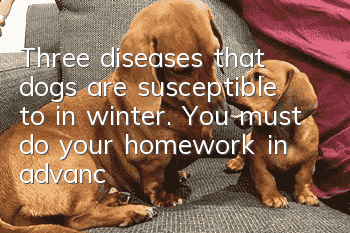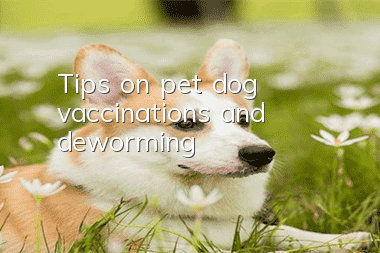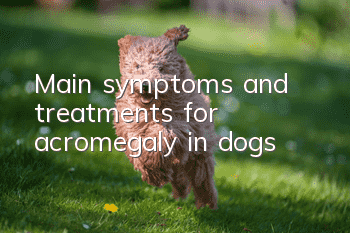Three diseases that dogs are susceptible to in winter. You must do your homework in advance!

Three diseases that dogs are susceptible to in winter
1. Canine infectious hepatitis
(1) Infection route: through digestive tract infection.(2) Symptoms of the disease: Acute cases include symptoms such as depression, chills, body temperature rising to about 40.5°C, loss of appetite, craving for water, vomiting, and diarrhea. In the later stage of acute symptoms, anemia, jaundice, pharyngitis, tonsillitis, and swollen lymph nodes can be seen; characteristic symptoms are also manifested in the eyes, with corneal turbidity turning blue, corneal and conjunctival edema, half-closed eyes, and large amounts of fluid. Serous discharge.
2. Canine adenovirus type II infection
Symptoms: incubation period of 5-6 days, persistent fever. Serous rhinorrhea in the nasal cavity can squirt outward through breathing. Paroxysmal dry cough occurred 6 to 7 days later, followed by wet cough, shortness of breath, gong sounds on tracheal auscultation, and oral examination revealed tonsil swelling and pharyngeal swelling. If the disease continues to progress, necrotizing pneumonia may occur. Dogs exhibit depression, lack of food, and vomiting. The disease is often complicated by canine distemper and other respiratory diseases. Mixed infections in dogs often result in difficult treatment and high mortality.
3. Coronavirus
(1) Infection route: contact with sick dogs, infection through respiratory tract and digestive tract.(2) Symptoms: frequent vomiting, diarrhea, anorexia, depression, dehydration and other symptoms. The incubation period is 1 to 3 days, and the sick dog shows lethargy, weakness, and anorexia. In the early stage, persistent vomiting can be seen for several days, followed by diarrhea, thin or watery feces, and sometimes mucus and a small amount of blood in the feces. The sick dogs show high dehydration, sunken eyeballs, decreased skin elasticity, rapid weight loss, and weight loss.
Infection route
The disease is mainly transmitted through contact and air. Therefore, contact with sick dogs and inhalation of droplets secreted by sick dogs are the main ways of contracting the disease. Canine distemper virus is present in large amounts in the respiratory secretions of sick dogs.2. Symptoms
Canine distemper begins with an increase in body temperature and lasts for 1 to 3 days. Then it subsides, much like recovery from a cold is characteristic of. But after a few days, the temperature rises again and continues indefinitely. Tears and redness of the conjunctiva can be seen, and eye secretions change from liquid to mucus and purulence. Dry nose, nasal discharge, first serous nasal discharge, and then turned into purulent nasal discharge. At the beginning of the disease, a dry cough turns into a wet cough and difficulty breathing. Vomiting, diarrhea and intussusception led to death from severe dehydration and weakness.
3. Prevention and treatment methods
(1) Regular vaccination. The canine distemper vaccine currently produced in my country is a cell culture attenuated vaccine. Puppies are immunized for the first time at 6 weeks of age; the second immunization is at 8 weeks of age; the third immunization is at 10 weeks of age, and they should still be immunized once a year in the future. The vaccines available are the six-combination vaccine and the five-combination vaccine currently on the market.(2) Once a sick dog with signs of canine distemper is found, the sick dog should be isolated immediately, and contact between the sick dog and healthy dogs is strictly prohibited.
(3) The kennels, objects and toys originally used by the sick dogs should be burned as much as possible, and the surrounding environment should be thoroughly disinfected with caustic soda, sodium hypoxonate, and poison.
(4) For dogs that have not yet developed symptoms and may be infected, and dogs that are threatened by the epidemic, immediately use canine distemper hyperimmune serum for emergency preventive injection.
(5) If the disease is prevalent in the local area, it is strictly forbidden to bring in outside dogs, and try to take dogs out as little as possible, and do not let dogs at home come into contact with other dogs.
Distinguish between dog colds and infectious diseases in winter
1. Cold
is a systemic symptom mainly characterized by inflammation of the upper respiratory tract mucosa.
(1) Cause: Sudden cold current stimulation, such as night wind in winter, sleeping in cold season, rain, failure to dry dog hair in time after bathing, etc.
(2) The main symptoms are: the sick dog is depressed, has loss of appetite or has no appetite, flushing of the conjunctiva, and eyes that are shy and tearful. There is a cough, pus-like nasal discharge, accelerated breathing, elevated body temperature, chills and tremors. If not treated in time, it may be complicated by other diseases such as tracheitis and bronchitis. There is also influenza, which is caused by a virus and is epidemic. The main manifestation is high fever. In addition to cold symptoms, it is often accompanied by conjunctivitis and intestinal catarrh.2. Symptoms of infectious diseases
The early symptoms are very similar to those of a cold. For example, early symptoms of canine distemper, early symptoms of parvovirus, etc., are generally clinically characterized by elevated body temperature, sneezing, shyness, tears, and watery nasal discharge. . Due to lack of experience, some owners tend to treat several common serious infectious diseases as colds, thus causing misdiagnosis and wrong treatment measures, leading to serious consequences of dog death.
Four.
Knowledge on dog health care in winter
1. Keep warm and coldWinter is the first time to pay attention to keeping warm and cold, because after exercise , blown away by wind and rain, and the dog's body temperature can cause colds and serious respiratory diseases such as bronchitis, pneumonia, etc. Protection from the cold is a top priority. The poop scooper should keep the kennel away from drafts and dry. Pets are not allowed to stay outdoors overnight. Short-haired puppies should also have thickened kennel bedding.
2. Exercise regularlyDon’t let your dog stay at home and sleep all the time. When the weather is sunny, you should often take your dog out to play, run, jump, etc. Exercise not only helps to improve the dog's immunity, but also increases fat burning and reduces fat accumulation caused by overeating fatty foods in winter. Dogs who exercise are energetic and healthy.
3. Balanced nutrition
Rich nutrition does not mean supplementation. In winter, when the temperature is low, dogs consume a lot of physical energy, and normal dietary standards cannot meet their needs. Therefore, when supplying a sufficient amount of protein food, corn, rice and other high-energy foods should be given at the same time. Animal and vegetable oils can be added if necessary. Such as broth or bone broth, etc. Vitamins should also be supplemented. With a strong body, dogs can resist the cold and reduce the occurrence of diseases.
4. Environmental hygiene
DogsThe house should be ventilated and kept clean. Dogs should develop good defecation habits and avoid the habit of defecating in the den. A good environment can enable dogs to gain an extraordinary mental outlook and reduce the occurrence of diseases.
5. Dry cleaning is required when bathingBathing dogs frequently is a hobby of many dog owners, but in winter, the frequency of bathing should be appropriately reduced. You should pay attention to technique when bathing. Partial cleaning or dry cleaning is the best way to bathe your dog in winter. It is best to do it in a sunny environment. Keep warm after washing to prevent colds.
6. Home
It is beneficial to open windows for ventilation for a period of time every day. In addition, the body of long-haired dogs is also preparing to keep out the cold during this season. The fur on their bodies increases and it is easy to tangle into balls, so they need to be groomed frequently. Combing can promote blood circulation and is like a full-body massage for dogs. Combing for a few minutes a day is not only good for dogs, but it can also comb the dog's fallen hair onto the comb, which is a great way to prevent dog hair from flying around at home. A good way.
7. Travel
As the weather gets cooler, it’s also the season when dogs are prone to catching colds. Most dogs are not too afraid of the cold and do not need to wear clothes when going out. However, some breeds are smaller and do not have thick fur to keep them warm. For example, dogs such as Chihuahuas and Fawns need to be clothed when going out. A piece of clothing is still necessary. If it catches up with autumn rain or winter rain, it is the most likely time for dogs to catch a cold. It’s best to wear a raincoat when your dog goes out. If you don’t have one, you have to go out in the rain. If you come back, be sure to keep it warm. Dry or blow dry your dog as much as possible and let him rest in a warm room. If you have some cold symptoms, you can give it some cold medicine just in case.
- How to choose a Giant Alaskan puppy?
- Dogs can also suffer from the "three highs" disease of wealth. How to prevent it?
- Is the Doberman Pinscher aggressive?
- What causes black dog hair to turn white?
- What causes tears in dog eyes?
- Dog sepsis symptoms
- Should I shave all my dog’s fetal hair when shaving it for the first time?
- What should I do if my dog eats less in hot weather?
- Why does a dog fart loudly?
- Can French cattle eat pineapple?



